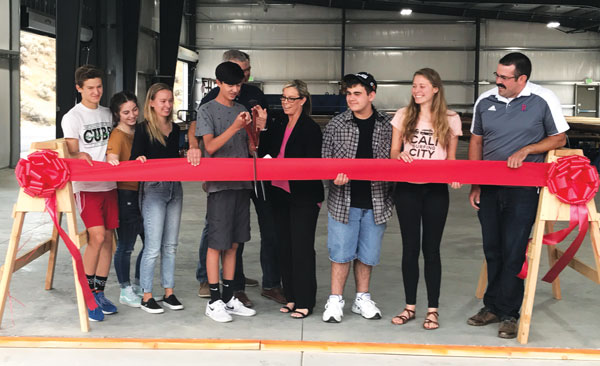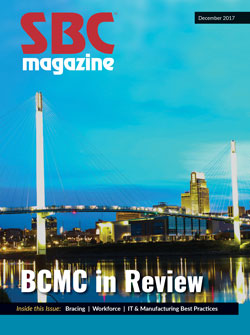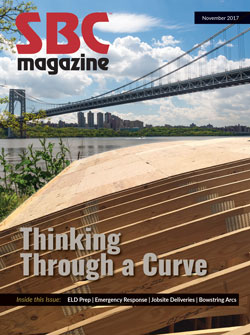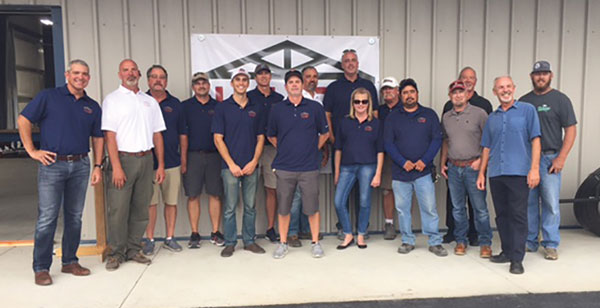Search
SBCA supports universal building installation of sprinklers for all types of construction, provided they are cost effective and do not create a competitive advantage for one structural element over another. When it comes to properly locating and designing sprinklers within a building, the IBC and IRC reference NFPA 13, 13D, and 13R (depending on the type of building). The resources below will assist the designer in understanding and implementing sprinkler systems in accordance with applicable building codes and referenced fire protection standards.
Integrating sprinkler systems into the open webbed configuration of metal plate connected wood trusses can be easy when following best practices. Truss construction can be manipulated with adjustments to panel lengths and web configurations to accommodate most special requirements. However, the Truss Designer needs to account for the additional weight of the sprinkler system and water. Additionally, construction loads encountered during installation need to be accounted for.
Mold can be found almost anywhere and can grow on virtually any substance, provided moisture is present. Mold differs from decay in that mold does not cause a decrease in the strength properties of lumber, however it can cause discoloration or odors on the lumber. The resources below will provide CM’s and builders with a better understanding of how mold can affect components, legal issues surrounding mold, as well as steps that can be taken to mitigate mold growth.
Field splicing is a method used to connect two or more truss sections into a single component. There are many reasons why field splicing may be used. A component may be too large or deep to manufacture, fit on a truck, or handle. A design modification or retrofit may necessitate a field splice, whether due to a change in truss profile or loading. Whatever the reason, field splices are another way to allow for greater flexibility in truss manufacturing, shipping and installation.
A truss may need to be modified or repaired due to accidental damage, holes or notches made by trades, errors in design or manufacturing, or a change requested by the customer. Trusses are typically designed for a specific application. Therefore, truss repairs or modifications must be analyzed on a case by case basis.
In the IECC, an air barrier is defined as “Material(s) assembled and joined together to provide a barrier to air leakage through the building envelope. An air barrier may be a single material or combination of materials.” The air barrier is an important part of integrated thermal and moisture control in a building. Many air barrier materials or strategies may be employed in a building that meet code requirements, however it is crucial to understand their interactions within the assembly.
Controlling sound transmission in buildings through wall, floor and ceiling assemblies is important for the comfort level and enjoyment of building occupants as they live, work and play in these buildings. Sound can come from a variety of sources: both internal to the building and environmental noise from the surrounding areas. The resources below explain how sound transmission is measured, and describe assemblies and other methods to limit noise transmission in buildings using components.
SBCA generates a large volume of timely, applicable information to its members and the industry at large on a wide variety of topics. Recognizing it can sometimes be difficult to locate a specific resource among this volume of content, we’ve created a topical library on the most prevalent subjects of interest to component manufacturers today. This topical library pulls together the most relevant articles, news items, best practices and other online resources on each topic.
I recently had a conversation with John Holland, head of IT for Clearspan Components, and he pointed out that if there’s one thing the component industry has a lot of, it’s problems
I know first-hand why everyone, from time to time, is hesitant to participate in or speak up at meetings: you’re afraid you’re going to be asked to take something on you’re not ready for or feel you don’t have time to do. Yet I still appeal to you to get engaged in SBCA.
Drivers will soon need to log their time electronically. Is your delivery crew prepared?
This is the second time in a decade Trussway employees have saved a life on the job.
Taking a finished product from plant to jobsite should be easy, but there can be bumps in the road. Here are a few best practices from two CMs in Wisconsin.
A complex roof with multiple arcing panels provided design challenges both before and during construction.
Erickson staff, including CEO Rich Gallagher (left) and COO Reed Graham (back row, right of center)

Reno Mayor Hillary Schieve (center), Reno High teacher Karl Kuhles (right) and his students in the STEM-based Project Lead the Way program, cut the ribbon to open the High Desert Truss and Lumber plant.

Articles
Lee Kirgan, construction manager for Operation Finally Home (OFH), has been busy making the rounds of SBCA chapter meetings. OFH is a non-profit organization that builds mortgage-free homes for wounded veterans and their families. In years past, SBCA partnered with OFH to build one home each year in the city that hosted BCMC. This year, SBCA’s relationship with OFH expanded nationwide.
As I talked to people throughout the week at BCMC, I kept hearing things that led me to conclude there’s a lot more unity in the industry these days.
A full-scale truss bracing demo was an eye-catching feature of the BCMC 2017 show floor.
NFC Executive Director Chris Tatge and SBCA staff member Jim Vogt demonstrated on the BCMC show floor just how quickly a structure comes together with wall panels.
High-stakes competition – at the table, out in the wind, and on the court – showed BCMC attendees know how to enjoy themselves both on and off the show floor. Congratulations to all the BCMC winners!
Thirty-five students and nine instructors from Omaha’s Metropolitan Community College (MCC) visited BCMC this year and got a taste of the many opportunities the structural building components industry has to offer.
There was so much information to absorb at this year’s show! And there are more resources online to help you catch up on anything you missed.
A single event can spark a continuous effort to make production more efficient.
Getting IT staff more involved in operational goals takes engagement from both sides.
To kick off BCMC, SBCA recognized those whose hard work and dedication make this industry what it is.
The SBCA Emerging Leaders Committee was created to give the next generation of leaders the structural building components industry and in SBCA an opportunity to meet one another, build lasting relationships, learn from other who will share their experience and gain a greater depth of knowledge of the industry and its trade association. The intent is to provide sustainability, growth and enthusiasm for member companies and the association.






